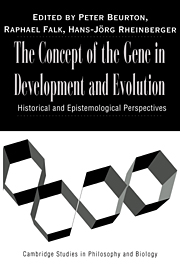Book contents
- Frontmatter
- Contents
- Introduction
- List of Authors
- PART ONE GENES AND TRAITS
- PART TWO EXTRACTING THE UNITS OF HEREDITY
- 4 From Measurement to Organization: A Philosophical Scheme for the History of the Concept of Heredity
- 5 From Gene to Genetic Hierarchy: Richard Goldschmidt and the Problem of the Gene
- 6 Seymour Benzer and the Definition of the Gene
- PART THREE GENETIC PROGRAMS AND DEVELOPMENTAL GENES
- PART FOUR CONCEPTUAL PERSPECTIVES
- FINAL REVIEW
- Glossary
- Index
5 - From Gene to Genetic Hierarchy: Richard Goldschmidt and the Problem of the Gene
from PART TWO - EXTRACTING THE UNITS OF HEREDITY
Published online by Cambridge University Press: 12 January 2010
- Frontmatter
- Contents
- Introduction
- List of Authors
- PART ONE GENES AND TRAITS
- PART TWO EXTRACTING THE UNITS OF HEREDITY
- 4 From Measurement to Organization: A Philosophical Scheme for the History of the Concept of Heredity
- 5 From Gene to Genetic Hierarchy: Richard Goldschmidt and the Problem of the Gene
- 6 Seymour Benzer and the Definition of the Gene
- PART THREE GENETIC PROGRAMS AND DEVELOPMENTAL GENES
- PART FOUR CONCEPTUAL PERSPECTIVES
- FINAL REVIEW
- Glossary
- Index
Summary
ABSTRACT
This paper examines Richard Goldschmidt's opposition to the classical concept of the gene as a combined unit of structure, function, mutation, and recombination. To replace the classical gene Goldschmidt articulated a genetic hierarchy drawing on the diverse strands of genetic research that had been bound together previously in the classical gene concept. As such, Goldschmidt's genetic hierarchies represent the possibility of retheorizing genetics without a unifying gene concept.
INTRODUCTION
Throughout the 1930s and 1940s Richard Goldschmidt took great pleasure in announcing the demise of the corpuscular gene. The resulting controversy surrounding Goldschmidt's opposition to the corpuscular gene is well known (Allen 1974; Burian 1985; Carlson 1966; Dunn 1965; Gilbert 1991; Maienschein 1992; Richmond 1986). While Goldschmidt relished claiming that the corpuscular gene was dead, his opponents did not refrain from stating, often in his presence, that he had gone crazy (Goldschmidt 1960, 323; Stern 967, [1980, 83]). The maelstrom of rhetoric surrounding Goldschmidt and the problem of the gene has, however, obscured the history of the development of alternatives to the corpuscular gene. Biologists, historians, and philosophers have characterized Goldschmidt's position as the chromosome-as-a-whole hypothesis. Such characterizations of Goldschmidt's views do not reflect the development of Goldschmidt's thought as much as the fact that most commentators have failed to come to terms with Goldschmidt's views after 1940. Elof Carlson, for instance, conflates Goldschmidt's early views (late 1930s) of the chromosome-as-a-whole with his later views that Carlson characterized as view of “the genetic continuum of the chromosome” (Carlson 1966,125,126,128).
- Type
- Chapter
- Information
- The Concept of the Gene in Development and EvolutionHistorical and Epistemological Perspectives, pp. 91 - 114Publisher: Cambridge University PressPrint publication year: 2000
- 13
- Cited by



